Weaknesses
The Club as originally designed was prone to having its lock shattered by freezing with freon; later models addressed this issue by changing to a chromium/molybdenum alloy. A television broadcast test showed that this form of attack now took several minutes of hammering. The most grievous flaw in the design is inherent in the modern construction of steering wheels; thieves can defeat this type of lock by making a cut through the steering wheel's outer rim, allowing the device to be removed. This does, however, require access to a hacksaw or other cutting tool, and ruins the steering wheel. However, after the Club has been removed, it can be used to assist the thief in breaking the steering lock built into the steering column; some thieves target cars "protected" with the Club over other cars for this reason. [2] An additional device called "The Cap" was made which added a metal cover over the steering wheel; this can also be defeated by replacing the entire steering wheel with a similar one. A newer variation was made with a pair of hooks on each end of the Club instead of one, thereby requiring two cuts with a hacksaw to remove, and thereby twice the time to remove.
In 2000, a device called the "Club Buster" was designed for locksmiths. It is a big screw with a hook on one end and a large handle on the other and two legs designed to rest on the lock. It breaks steering wheel locks such as the Club by hooking onto the lock and tightening the screw with the handle. The large handle provides mechanical advantage, concentrating the force applied by the hook and eventually forcing the lock to fold in half or snap in two.
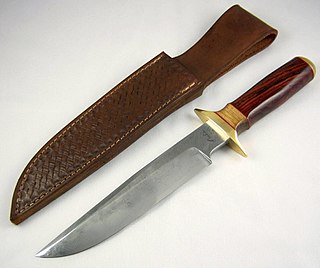
A knife is a tool or weapon with a cutting edge or blade, usually attached to a handle or hilt. One of the earliest tools used by humanity, knives appeared at least 2.5 million years ago, as evidenced by the Oldowan tools. Originally made of wood, bone, and stone, over the centuries, in step with improvements in both metallurgy and manufacturing, knife blades have been made from copper, bronze, iron, steel, ceramic, and titanium. Most modern knives have either fixed or folding blades; blade patterns and styles vary by maker and country of origin.

A bicycle wheel is a wheel, most commonly a wire wheel, designed for a bicycle. A pair is often called a wheelset, especially in the context of ready built "off the shelf" performance-oriented wheels.

A steering wheel is a type of steering control in vehicles.
Automobile handling and vehicle handling are descriptions of the way a wheeled vehicle responds and reacts to the inputs of a driver, as well as how it moves along a track or road. It is commonly judged by how a vehicle performs particularly during cornering, acceleration, and braking as well as on the vehicle's directional stability when moving in steady state condition.
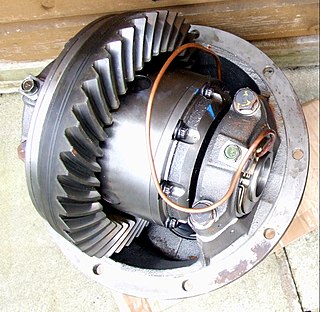
A locking differential is a mechanical component, commonly used in vehicles, designed to overcome the chief limitation of a standard open differential by essentially "locking" both wheels on an axle together as if on a common shaft. This forces both wheels to turn in unison, regardless of the traction available to either wheel individually.

The wheel size for a motor vehicle or similar wheel has a number of parameters.
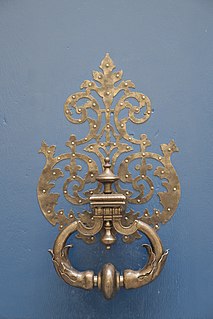
A door handle or doorknob is a handle used to open or close a door. Door handles can be found on all types of doors including exterior doors of residential and commercial buildings, internal doors, cupboard doors and vehicle doors. There are many designs of door handle, depending on the appropriate use. A large number of handles, particularly for commercial and residential doors, incorporate latching or locking mechanisms or are manufactured to fit to standardised door locking or latching mechanisms.

A ship's wheel or boat's wheel is a device used aboard a water vessel to steer that vessel and control its course. Together with the rest of the steering mechanism, it forms part of the helm. It is connected to a mechanical, electric servo, or hydraulic system which alters the horizontal angle of the vessel's rudder relative to its hull. In some modern ships the wheel is replaced with a simple toggle that remotely controls an electro-mechanical or electro-hydraulic drive for the rudder, with a rudder position indicator presenting feedback to the helmsman.

A bicycle lock is a security device used to deter bicycle theft, either by simply locking one of the wheels or by fastening the bicycle to a fixed object, e.g., a bike rack.
A beadlock or bead lock is a mechanical device that secures the bead of a tire to the wheel of a vehicle. Tires and wheels are designed so that when the tire is inflated, the tire pressure pushes the bead of the tire against the inside of the wheel rim so that the tire stays on the wheel and the two rotate together. In situations where tire pressure is insufficient to hold the bead of the tire in place, a beadlock is needed.
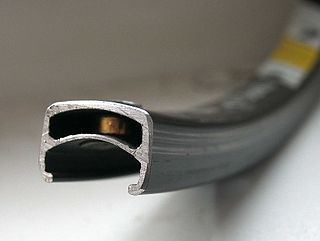
The rim is the "outer edge of a wheel, holding the tire". It makes up the outer circular design of the wheel on which the inside edge of the tire is mounted on vehicles such as automobiles. For example, on a bicycle wheel the rim is a large hoop attached to the outer ends of the spokes of the wheel that holds the tire and tube. In cross-section, the rim is deep in the center and shallow at the outer edges, thus forming a "U" shape that supports the bead of the tire casing.
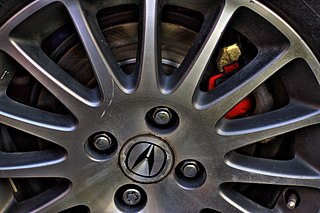
A lug nut or wheel nut is a fastener, specifically a nut, used to secure a wheel on a vehicle. Typically, lug nuts are found on automobiles, trucks (lorries), and other large vehicles using rubber tires.
Teletouch was the trade name for the transmission controls found on many Edsel brand automobiles manufactured by the Edsel and Mercury-Edsel-Lincoln (M-E-L) Divisions of the Ford Motor Company. The significance of the Teletouch systems lies in its conception, design and symbolism for American automobiles produced in the 1950s, and the gadgets designed into them. The main distinguishing feature of the system was its use of push buttons on the steering wheel to shift gears as opposed to a gear stick.

In the automotive industry, alloy wheels are wheels that are made from an alloy of aluminium or magnesium. Alloys are mixtures of a metal and other elements. They generally provide greater strength over pure metals, which are usually much softer and more ductile. Alloys of aluminium or magnesium are typically lighter for the same strength, provide better heat conduction, and often produce improved cosmetic appearance over steel wheels. Although steel, the most common material used in wheel production, is an alloy of iron and carbon, the term "alloy wheel" is usually reserved for wheels made from nonferrous alloys.
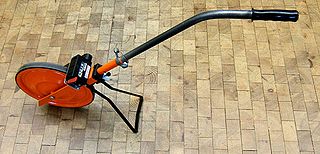
A surveyor's wheel, also called a clickwheel, hodometer, waywiser, trundle wheel, measuring wheel or perambulator is a device for measuring distance.
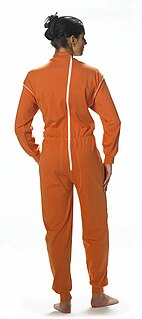
Locking clothing are garments which prevent the person wearing the clothing from removing the clothing. One example would be clothing designed to prevent a person with dementia from inappropriate undressing.
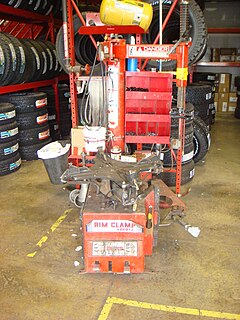
A tire changer is a machine used to help tire technicians dismount and mount tires with automobile wheels. After the wheel and tire assembly are removed from the automobile, the tire changer has all the components necessary to remove and replace the tire from the wheel. Different tire changers allow technicians to replace tires on automobiles, motorcycles and heavy-duty trucks. New tire and wheel technology has improved certain tire changers to be able to change a low profile tire or a run-flat tire.

James Earl "Jim" Winner, Jr. was an American entrepreneur and chairman of Winner International who created The Club, an anti-theft device that is attached and locked on to a car's steering wheel, making it more difficult for car thieves to steal the car. By 1994, sales of the device had reached 14 million units.
A centerlock wheel is a type of automobile wheel in which the wheel is fastened to the axle using a single, central nut, instead of the more common ring of 4 or 5 lug nuts or bolts.















